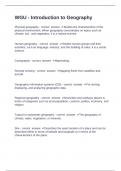WGU - Introduction to Geography
Physical geography - correct answer ✔Studies the characteristics of the
physical environment. When geography concentrates on topics such as
climate, soil , and vegetation, it is a natural science.
Human geography - correct answer ✔Studies human groups and their
activities, such as language, industry, and the building of cities; it is a social
science.
Cartography - correct answer ✔Mapmaking.
Remote sensing - correct answer ✔Mapping Earth from satellites and
aircraft.
Geographic information systems (GIS) - correct answer ✔For storing,
displaying, and analyzing geographic data.
Regional geography - correct answer ✔Describes and analyzes places in
terms of categories such as local population, customs, politics, economy, and
religion.
Topical or systematic geography - correct answer ✔The geography of
climate, water, vegetation, or minerals.
Site - correct answer ✔Describes the exact location of a place and can be
described either in terms of latitude and longitude or in terms of the
characteristics of the place.
,Situation - correct answer ✔The location of a place relative to other places,
and knowledge of a place's situation helps us understand how it interacts with
the rest of the world.
Relative location - correct answer ✔Location in reference to another place.
Relative location may describe accessibility, which is indicated by terms such
as nearer and farther, easier or more difficult to reach, between, and on the
way or out of the way.
Globalization - correct answer ✔Many activities have expanded their scale of
organization to cover the whole globe, which is a process called globalization.
Economic globalization has far outpaced cultural or political integration.
Regions - correct answer ✔Areas defined by one or more distinctive
characteristics or features, such as climate, soil type, language, or economic
activity.
Formal region - correct answer ✔One that exhibits essential uniformity in one
or more physical or cultural features, such as a climate type or language area.
Functional region - correct answer ✔One defined by interactions among
places, such as trade or communication. The city of Chicago, for example, is a
formal region, whose government covers the legal limits of the city's
incorporation. The many commuters and shoppers who circulate daily
throughout the city and its suburbs, however, would more readily identify a
region larger than Chicago; they would identify the functional region of the
Chicago metropolitan area, or "Chicagoland," which includes parts of Illinois,
Indiana, and even Wisconsin. The desire of people in northwest Indiana to be
in the same time zone as Chicago confirms that northwest Indiana is part of
the Chicago functional region.
, Vernacular region - correct answer ✔Vernacular means "everyday
language," and vernacular regions are defined by widespread popular
perception of their existence by people within or outside them.
Spatial analysis - correct answer ✔Looks for patterns in the distribution of
human actions, environmental processes, and interactions among and
between places or regions.
Distribution - correct answer ✔Its position, placement, or arrangement
throughout space.
Density - correct answer ✔The frequency of occurrence of a phenomenon in
relation to geographic area, usually expressed as a number per square
kilometer or square mile. Examples include road density (the number of
kilometers of roads per square kilometer) and population density (the number
of people per square kilometer).
Concentration - correct answer ✔The distribution of a phenomenon within a
given area is described by concentration. If all the occurrences are found in
close proximity, the distribution would be described as concentrated, but if
they are scattered far from each other, the distribution would be described as
dispersed. For example, in many parts of the world farmers live in villages and
travel to their fields in the countryside. The population of such an agricultural
landscape is concentrated in villages. In North America, on the other hand,
most farmers live in isolated farmhouses located on the land they farm, so the
population is dispersed.
Pattern - correct answer ✔Refers to the geometric arrangement of objects
within an area. For example, in most modern cities, streets are arranged in a
rectangular grid pattern, whereas in older cities the street layout is more
irregular. In areas where rock structures exert strong controls on stream
erosion, we sometimes see streams with many right-angle bends; this pattern
is called a trellis pattern. Conversely, in areas without structural control,




